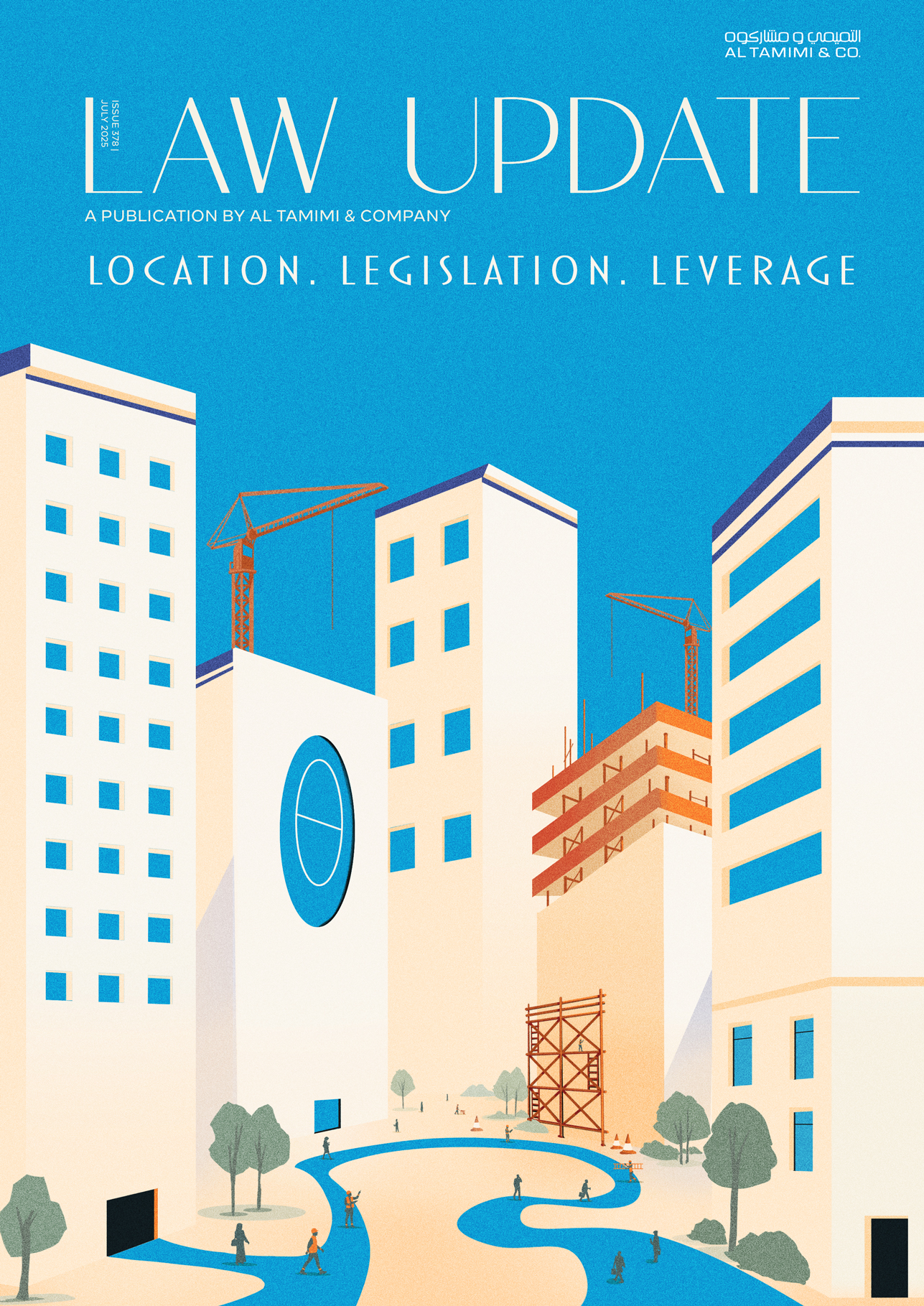- Arbitration
- Banking & Finance
- Capital Markets
- Commercial
- Competition
- Construction & Infrastructure
- Corporate / Mergers & Acquisitions
- Corporate Services
- Corporate Structuring
- Digital & Data
- Dispute Resolution
- Employment & Incentives
- Family Business & Private Wealth
- Innovation, Patents & Industrial Property (3IP)
- Insurance
Find a Lawyer
Book an appointment with us, or search the directory to find the right lawyer for you directly through the app.
Find out more
Real Estate & Construction and Hotels & Leisure
Real estate, construction, and hospitality are at the forefront of transformation across the Middle East – reshaping cities, driving investment, and demanding increasingly sophisticated legal frameworks.
In the June edition of Law Update, we take a closer look at the legal shifts influencing the sector – from Dubai’s new Real Estate Investment Funds Law and major reforms in Qatar, to Bahrain’s push toward digitalisation in property and timeshare regulation. We also explore practical issues around strata, zoning, joint ventures, and hotel management agreements that are critical to navigating today’s market.
As the landscape becomes more complex, understanding the legal dynamics behind these developments is key to making informed, strategic decisions.


2025 is set to be a game-changer for the MENA region, with legal and regulatory shifts from 2024 continuing to reshape its economic landscape. Saudi Arabia, the UAE, Egypt, Iraq, Qatar, and Bahrain are all implementing groundbreaking reforms in sustainable financing, investment laws, labor regulations, and dispute resolution. As the region positions itself for deeper global integration, businesses must adapt to a rapidly evolving legal environment.
Our Eyes on 2025 publication provides essential insights and practical guidance on the key legal updates shaping the year ahead—equipping you with the knowledge to stay ahead in this dynamic market.
The leading law firm in the Middle East & North Africa region.
A complete spectrum of legal services across jurisdictions in the Middle East & North Africa.
-
Practices
- All Practices
- Banking & Finance
- Capital Markets
- Commercial
- Competition
- Construction & Infrastructure
- Corporate / Mergers & Acquisitions
- Corporate Services
- Corporate Structuring
-
Sectors
-
Country Groups
-
Client Solutions
Today's news and tomorrow's trends from around the region.
17 offices across the Middle East & North Africa.
Our Services
 Back
Back
-
Practices
- All Practices
- Banking & Finance
- Capital Markets
- Commercial
- Competition
- Construction & Infrastructure
- Corporate / Mergers & Acquisitions
- Corporate Services
- Corporate Structuring
- Digital & Data
- Dispute Resolution
- Employment & Incentives
- Family Business & Private Wealth
- Innovation, Patents & Industrial Property (3IP)
- Insurance
- Intellectual Property
- Legislative Drafting
- Private Client Services
- Private Equity
- Private Notary
- Projects
- Real Estate
- Regulatory
- Tax
- Turnaround, Restructuring & Insolvency
- Compliance, Investigations and White-Collar Crime
-
Sectors
-
Country Groups
-
Client Solutions
- Law Firm
- /
- Insights
- /
- Law Update
- /
- June – July 2016
- /
- Changes Expected to the Saudi Arabian Bankruptcy Law
Changes Expected to the Saudi Arabian Bankruptcy Law
Hesham Al Homoud - Partner, Head of Corporate Structuring - Saudi Arabia - Corporate Structuring / Commercial / Corporate / Mergers and Acquisitions
June – July 2016
The Ministry of Commerce and Investment is currently in the latter stages of reforming the Kingdom’s bankruptcy laws and regulations. The new Law is intended to replace certain sections in the Commercial Court Law and the Bankruptcy Protecting Settlement Law dealing with bankruptcy.
The new Law comprises detailed rules designed to create a legal framework aimed at protecting the number and size of private investment projects through the preservation of the economic value that those projects add to the economy. To achieve this, the new Law gives priority to the provision of assistance to debtors through reconciliation procedures for the debtor that is financially stressed, enabling reorganisation of the debtor’s business.
The new Law will adopt a number of mechanisms designed to increase the prospects of success of the above objectives. As an example, a creditor may not be allowed to take any action against the debtor beyond the actions stipulated in the new Law. One such available action will be to permit or prevent the implementation of enforcement requests on security interests (charges/mortgages) when enforcement could actually result in stopping a debtor from pursuing an opportunity to reach a settlement with all creditors.
The new Law also empowers the judicial authorities to oblige creditors to accept the arrangement proposed by a debtor that is in dire financial difficulties to settle its debts. The judicial authorities may also prevent the parties involved in contracts with the debtor from exercising an option to terminate the relevant contract in circumstances where the termination relates to a debtor in default, in serious financial difficulty or even when the debtor is entering a stage of bankruptcy.
From the creditor’s perspective, the new Law recognises the importance of preserving creditors’ rights by distinguishing between debtors having a reasonable opportunity to resume their business where they can fulfil their obligations, from those debtors who are not expected to bring their business back to a level that could satisfy the creditors’ expectations and achieve settlement of their financial obligations.
It is also understood that there will be restrictions relating to debtors exercising certain rights against creditors. For example, the majority of creditors must approve debt settlement arrangements, creditors must adhere to the ranking of the debts and some sort of priority may be given to those creditors that have not exercised their termination rights.
The new Law is expected to include a number of provisions particularly dealing with small and medium size companies in order to encourage the growth of these types of businesses. Small and medium size entities facing financial difficulties will be treated differently in terms of rectifying those difficulties.
In addition, the new Law is also expected to be in line with the business activities report issued by the International Bank for 2015, which indicates that developed bankruptcy regulations provide solutions to maintain the continuity of projects that face financial difficulties, thereby enabling these projects to survive and then continue to operate efficiently. The main purpose of any developed bankruptcy law is to bring back the debtor to its normal business practice as soon as possible and to increase the settlement of debts.
On the other hand, the new Law will address those projects that are faced with financial difficulties and lacking in operational efficiency to such an extent that the ability to continue is compromised. In these circumstances, the new Law will propose liquidation and the placement of the remaining assets under proper management moving forward.
Whilst some legal commentators anticipate that the new Law will be issued during 2016, most will expect that this will not occur prior to the first quarter of 2017.
Stay updated
To learn more about our services and get the latest legal insights from across the Middle East and North Africa region, click on the link below.


